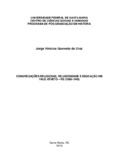| dc.creator | Cruz, Jorge Vinicius Quevedo da | |
| dc.date.accessioned | 2019-06-12T12:56:15Z | |
| dc.date.available | 2019-06-12T12:56:15Z | |
| dc.date.issued | 2019-01-09 | |
| dc.identifier.uri | http://repositorio.ufsm.br/handle/1/16961 | |
| dc.description.abstract | This abstract has the purpose of presenting the dissertation entitled "religious congregations, religiosity and education in Vale Vêneto – RS (1886-1945)". From the bibliographical and documentary research we seek to demonstrate how the present religiosity among the Italian immigrants established in Vale Vêneto, community located in the region of the Fourth Immigration Colony of the State of Rio Grande do Sul, manifested through works built in the colonial nucleus, due to the presence of the Catholic Church which saw in education a way of strengthening the ties of cultural identity of immigrants who were mostly catholics.The settlers sought through the Church a form of progress for that region. On the other hand, the religious institution saw in the emigration of Italians to the South of Brazil a way of reinforcing the power and influence of the romanized clergy. In this context, the Pallottine Congregation and the Sisters of the Immaculate Heart of Mary played an important role among the inhabitants of that region through the construction of a network of religious and educational assistance. Therefore, we question the role of these religious congregations in the construction of forms of sociability, at the same time, creating bases for the organization of a religious field favorable to catholicism. This study aims to understand how religiousness among a group of Italian immigrants played an important role in the process of formation of the locality of Vale Vêneto, through the effort of its inhabitants who sought to build a link between religious, education and community life. This work is linked to the activities developed in the Research Line "Culture, Migrations and Labor", of the Graduate-Program in History of the Federal University of Santa Maria. | eng |
| dc.language | por | por |
| dc.publisher | Universidade Federal de Santa Maria | por |
| dc.rights | Attribution-NonCommercial-NoDerivatives 4.0 International | * |
| dc.rights.uri | http://creativecommons.org/licenses/by-nc-nd/4.0/ | * |
| dc.subject | Imigração italiana | por |
| dc.subject | Religiosidade | por |
| dc.subject | Restauração católica | por |
| dc.subject | Educação | por |
| dc.subject | Vale Vêneto | por |
| dc.subject | Italian immigration | eng |
| dc.subject | Religiosity | eng |
| dc.subject | Catholic restoration | eng |
| dc.title | Congregações religiosas, religiosidade e educação em Vale Vêneto – RS (1886-1945) | por |
| dc.title.alternative | Religious congregations, religiosity and education in Vale Vêneto – RS (1886-1945) | eng |
| dc.type | Dissertação | por |
| dc.description.resumo | Esse resumo tem por objetivo apresentar a dissertação intitulada “Congregações religiosas, religiosidade e educação em Vale Vêneto – RS (1886 -1945)”. A partir da pesquisa bibliográfica e documental buscamos demonstrar como a religiosidade presente entre imigrantes italianos estabelecidos em Vale Vêneto, comunidade localizada na Quarta Colônia de Imigração Italiana do Estado do Rio Grande do Sul, se manifestou através de obras construídas naquele núcleo colonial, haja vista a presença da Igreja Católica que via na educação uma forma de reforçar os laços de identidade cultural dos imigrantes que em sua maioria eram católicos. Os colonos buscavam através da Igreja uma forma de progresso para aquela região. Em contrapartida, a instituição religiosa via na emigração de italianos para o Sul do Brasil uma forma de reforçar o poder e a influência do clero romanizado. Nesse contexto, a Congregação Palotina e as Irmãs do Imaculado Coração de Maria tiveram um papel importante entre os habitantes daquela região, através da construção de uma rede de assistência religiosa e educacional. Portanto, questionamos qual o papel dessas congregações religiosas na construção de formas de sociabilidade, ao mesmo o tempo, criando bases para a organização de um campo religioso favorável para o catolicismo. Com esse estudo visamos compreender como a religiosidade entre um determinado grupo de imigrantes italianos constituiu um papel importante no processo de formação da localidade de Vale Vêneto, através do empenho de seus habitantes que buscaram construir um elo entre o religioso, a educação e a vida comunitária. Este trabalho está vinculado às atividades desenvolvidas na Linha de Pesquisa “Cultura, Migrações e Trabalho”, do Programa de Pós-Graduação em História da Universidade Federal de Santa Maria. | por |
| dc.contributor.advisor1 | Borin, Marta Rosa | |
| dc.contributor.advisor1Lattes | http://lattes.cnpq.br/5887358764231724 | por |
| dc.contributor.referee1 | Santos, Julio Ricardo Quevedo dos | |
| dc.contributor.referee1Lattes | http://lattes.cnpq.br/6418022027415183 | por |
| dc.contributor.referee2 | Rocha, Aristeu Castilhos da | |
| dc.contributor.referee2Lattes | http://lattes.cnpq.br/3178211577215938 | por |
| dc.creator.Lattes | http://lattes.cnpq.br/0719960821351716 | por |
| dc.publisher.country | Brasil | por |
| dc.publisher.department | História | por |
| dc.publisher.initials | UFSM | por |
| dc.publisher.program | Programa de Pós-Graduação em História | por |
| dc.subject.cnpq | CNPQ::CIENCIAS HUMANAS::HISTORIA | por |
| dc.publisher.unidade | Centro de Ciências Sociais e Humanas | por |



